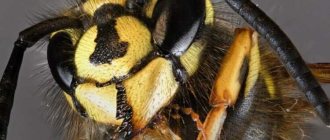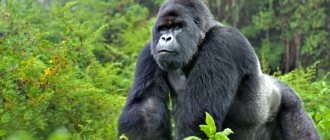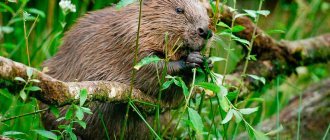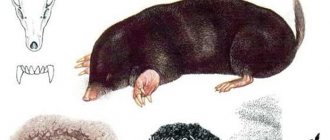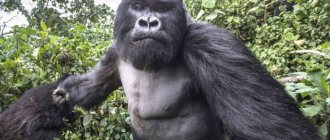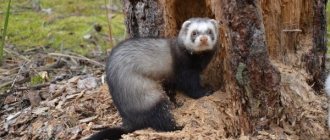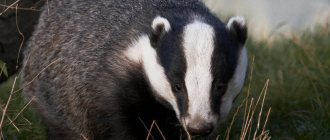Description of the gorilla
The height of an adult male gorilla reaches 1.65-1.75 meters. Sometimes you can find individuals up to 2 meters tall, but no more than that. The shoulder width of such an animal can be 1 meter. The average weight of a male is approximately 150 kg. Female gorillas are 2 times smaller in size. The body of such a primate is massive and has developed muscles. The strength of every gorilla is enormous. The coat of such a monkey is dark and with a silver stripe on the back in adult males. Their front legs are longer than their hind legs. Such a monkey has powerful feet and strong hands. A gorilla can walk on its hind legs, but most often this animal moves on all fours. When walking, such a monkey does not rely on the palm of the hand and on the pads of the fingers of the forelimbs, like other primates, but on the outer side of the fingers, which are gathered into a fist. At the same time, sensitive thin skin remains on the inside of the gorilla's hand. The head of such a primate is large, the forehead is low, and the jaw protrudes forward.
Possibility of home maintenance
The gorilla belongs to the category of social animals, for which it is quite natural to stay in groups. This largest representative of monkeys is extremely rarely kept at home , due to its impressive size and features of tropical origin. The animal is often housed in zoos, but in captivity the gorilla lives up to fifty years at best.
Tags: habitat, eastern gorilla, gorilla, wild animals, western gorilla, gorilla nutrition, natural enemies
Gorilla nutritional features
Gorillas eat plant foods. Their diet may include plants such as bedstraw, wild celery, nettles and bamboo. In addition, they willingly eat various fruits and nuts, and do not consume food of animal origin. If a young gorilla is placed in captivity, it quickly adapts to being fed any food.
Gorillas also need mineral supplements. Such monkeys practically do not drink, because they get all the moisture they need from succulent vegetation. They avoid bodies of water and water, and do not like rain at all.
Natural nutrition
The gorilla spends a significant part of its time in search of food. To find food for itself, the animal is able to methodically walk around the territory along constant and well-known paths. Primates move on four limbs. Gorillas of any kind are absolute vegetarians, so only vegetation is used for nutrition. Preference is given to the foliage and stem parts of various plants.
This is interesting! The food consumed by gorillas has a small amount of useful substances, so the large primate needs to eat about eighteen to twenty kilograms of such food daily.
Contrary to long-established, popular belief, only a small part of the diet of the eastern gorilla is represented by fruits. The western gorilla, on the contrary, prefers fruits , therefore, in search of suitable fruit trees, the large animal is able to cover quite long distances. The low calorie content of food forces animals to spend a lot of time searching for food and feeding themselves. Due to receiving large amounts of liquid from plant foods, gorillas rarely drink.
Common Gorilla Species
According to the modern classification, the gorilla genus includes 2 subspecies.
Genus Western gorilla (Gorilla gorilla)
- Western lowland gorilla (Gorilla gorilla gorilla). She lives in the mountains of the Republic of Congo, Cameroon, Angola, Central African Republic, Equatorial Guinea and Gabon. These gorillas are often kept in zoos. They differ from their relatives in their smaller size. The height of the male at the shoulders reaches 2 meters, and the weight is 140 kg. Females can be 1.5 meters in height, and their weight is 70 kg. This species is vulnerable because it is adversely affected by deforestation and poaching.
- Western river gorilla (Gorilla gorilla diehli). The habitat of this subspecies extends between Nigeria and Cameroon, where primates of this type can be found in tropical and subtropical deciduous forests. This species is the most vulnerable of all the others. This gorilla differs from its lowland relative in its body structure and the size of its skull and teeth.
Genus Eastern gorilla (Gorilla beringei)
- Mountain gorilla (Gorilla beringei beringei). This gorilla species is endangered. Their habitat is limited to Central Africa. These mountain gorillas live on the slopes of extinct volcanoes, at an altitude of 2200-4300 meters above sea level. In size, such individuals are second only to the eastern lowland species. The average weight of a male can reach up to 195 kg, and height - up to 150 cm. Females weigh up to 100 kg with a height of 130 cm.
Population and species status
These unique inhabitants of our Planet are on the verge of complete extinction, all thanks to human activity. The Europeans brought, in addition to hunting for them, some deadly diseases to which the gorillas’ body had no immunity. As a result, a large number of such animals died.
In addition to the fact that humans directly influence gorilla populations, they also indirectly cause them to suffer from the reduction of forest areas in their natural habitats. As forests are cut down, there are fewer and fewer areas where gorillas would feel comfortable. There is another negative factor - these are wars that are kindled on the lands where such creatures live. As a result, not only people suffer, but also the surrounding nature.
In addition to the western and eastern gorillas, there are 4 more subspecies:
- The western lowland gorilla is considered a vulnerable subspecies, but no conservation measures are applied to it. The total number of the subspecies is at the level of 130-200 thousand individuals. Assigned the conservation status of “critically endangered”.
- The western river gorilla lives in areas that are hundreds of kilometers away from the habitat of the lowland gorilla. The total number of this subspecies is estimated at only 300 individuals, so the subspecies is given the same status.
- Eastern mountain gorilla. At the beginning of the 21st century, the number of the subspecies was estimated at 650 individuals, and currently it has increased to 1 thousand individuals, which is considered great progress. Assigned "endangered species" status.
- Eastern lowland gorilla. Their population consists of about 5 thousand individuals. This is evidence that the subspecies is in danger of extinction, despite the fact that this subspecies is in more comfortable living conditions.
Gorilla behavior
Gorillas live in small groups consisting of a leader, several females and their children. These animals are quite calm and peaceful, and spend a lot of their free time looking for food. The leader male and the lone male do not engage in a fight when they meet, but simply show each other their own power. Gorillas do not attack other animals, but they are able to defend themselves from attack.
See Gelada: general description of the primate
The first part of a gorilla's day is spent searching for food. Next they walk through the forests. When it's very hot outside, their activity decreases. Such monkeys rest lying on the ground or in nests specially built for this purpose.
When it gets late in the day, the gorillas' activities end and the group goes to bed.
At the head of each such group of gorillas is the oldest and most powerful male. He determines the daily routine, the search for food and selects a place to sleep. He gains his own authority by performing a terrifying “dance”, but this is only an indicative threat: even a furious male will almost never attack. Thus, attacks by gorillas on humans are also rarely described. The “dance” of a gorilla can begin with a quiet hoot, which later turns into heart-rending screams. Next, the gorilla will rise to its feet and, hunching its shoulders, begin to beat its chest with its fists. After this, the male will straighten up, run up, and, falling on 4 limbs, run away through the bushes with a crash, crushing everything around him. Finally, he will tap the ground with his palms. In groups with gorillas, quarrels are typical mainly for females. When attacking animals, all are defended by males.
Habitat
All subspecies of the eastern gorilla are naturally distributed in subalpine forest zones in lowland and mountainous areas located in the eastern part of the Democratic Republic of the Congo, as well as in the southwest of Uganda and Rwanda. Large groups of primates of this species are found in the areas between the Lualaba River, Lake Edward and the Tanganyika deep-sea reservoir. The animal prefers forests that have a dense grassy floor.
This is interesting! A gorilla's day is scheduled literally minute by minute and begins with a short walk around the nest, eating leaves or grass. During the lunch break, the animals rest or sleep. And the second half of the day is completely devoted to building a nest or arranging it.
Western river and lowland gorilla families live in lowlands, tropical forests and plains in Cameroon, Central African Republic. Also, a large number of primates of this species inhabit the mainland of Equatorial Guinea, Gabon, Nigeria, the Republic of Congo and Angola.
Gorilla breeding
Sexual maturity in a gorilla occurs at the age of 10-12 years, in males - at 11-13 years. Females are always caring and loving mothers, and males are attentive fathers. Gorilla pregnancy lasts 8.5 months. After this, 1 cub is born weighing approximately 2 kg, which is completely dependent on the female: she feeds it, carries it, protects it and emotionally supports it until the age of 3. After this, the young gorilla begins to live independently. The lifespan of all gorillas is from 30 to 50 years.
Watch a movie about gorillas
In nature, this species of monkey lives only in Central and Equatorial Africa. All gorilla subspecies are endangered and are listed in the Red Book.
The leader of a herd of gorillas is always the strongest. The aged leader is replaced by a young male. The “change of power” is happening peacefully. Adult animals do not sort things out with each other. A family group occupies a very small territory; the possessions of several herds may overlap, but conflicts between them are extremely rare.
During the midday heat, animals begin to clean their fur and remove parasites from it. Most often, adolescents take care of themselves, then females, and males close the ranking in cleaning. The cubs are cleaned by the mother. Gorillas are very gentle mothers and never spank their babies. Female gorillas do not take part in cleaning the fur of males, even if he is the owner of a silver back. After a midday rest, the entire herd moves to new areas in search of food. The leader of the family is always at the head, and the younger male, who does not have gray hair on his back, closes the family. Every evening, gorillas make night nests in tree branches. Such sockets are never used twice.
A baby gorilla needs care for 3 years and sleeps with its mother.
